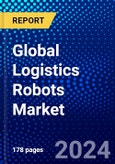The Global Logistics Robots Market is estimated to be USD 8.1 Bn in 2023 and is expected to reach USD 35.29 Bn by 2028 growing at a CAGR of 34.21%.According to a study analyzing the impact of robotics on logistics up to 2025, Logistics Robots will reduce of logistics costs by between 20% and 40% and increase productivity by between 25% and 70%
Market Dynamics
Market dynamics are forces that impact the prices and behaviors of the stakeholders. These forces create pricing signals which result from the changes in the supply and demand curves for a given product or service. Forces of Market Dynamics may be related to macro-economic and micro-economic factors. There are dynamic market forces other than price, demand, and supply. Human emotions can also drive decisions, influence the market, and create price signals.As the market dynamics impact the supply and demand curves, decision-makers aim to determine the best way to use various financial tools to stem various strategies for speeding the growth and reducing the risks.
Market Segmentations
- The Global Logistics Robots Market is segmented based on Product, Function, Applications, End-User, and Geography.
- By Product, the market is classified into Articulated Robotic Arms, Automated Guided Carts, Automated Guided Vehicles, Automated Storage & Retrieval Systems, Autonomous Mobile Robots, and Goods-to-Person Technology.
- By Function, the market is classified into Palletizing and De-palletizing, Pick and Place, Loading and Unloading, Packaging and Co-packing, and Shipment and Delivery.li>
- By Applications, the market is classified into Indoor and Outdoor.li>
- By End-User, the market is classified into Retail & E-Commerce, Healthcare, Manufacturing, and Others.li>
- By Geography, the market is classified into Americas, Europe, Middle-East & Africa, and Asia-Pacific.
Company Profiles
The report provides a detailed analysis of the competitors in the market. It covers the financial performance analysis for the publicly listed companies in the market. The report also offers detailed information on the companies' recent development and competitive scenario. Some of the companies covered in this report are Omron Corp., Toshiba Corp., Toyota Industries Corp., Amazon.com, Inc., Automation Tooling Systems Inc., Hitachi Ltd., etc.Countries Studied
- America (Argentina, Brazil, Canada, Chile, Colombia, Mexico, Peru, United States, Rest of Americas)
- Europe (Austria, Belgium, Denmark, Finland, France, Germany, Italy, Netherlands, Norway, Poland, Russia, Spain, Sweden, Switzerland, United Kingdom, Rest of Europe)
- Middle-East and Africa (Egypt, Israel, Qatar, Saudi Arabia, South Africa, United Arab Emirates, Rest of MEA)
- Asia-Pacific (Australia, Bangladesh, China, India, Indonesia, Japan, Malaysia, Philippines, Singapore, South Korea, Sri Lanka, Thailand, Taiwan, Rest of Asia-Pacific)
Competitive Quadrant
The report includes Competitive Quadrant, a proprietary tool to analyze and evaluate the position of companies based on their Industry Position score and Market Performance score. The tool uses various factors for categorizing the players into four categories. Some of these factors considered for analysis are financial performance over the last 3 years, growth strategies, innovation score, new product launches, investments, growth in market share, etc.Ansoff Analysis
- The report presents a detailed Ansoff matrix analysis for the Global Logistics Robots Market. Ansoff Matrix, also known as Product/Market Expansion Grid, is a strategic tool used to design strategies for the growth of the company. The matrix can be used to evaluate approaches in four strategies viz. Market Development, Market Penetration, Product Development and Diversification. The matrix is also used for risk analysis to understand the risk involved with each approach.
- The publisher analyses the Global Logistics Robots Market using the Ansoff Matrix to provide the best approaches a company can take to improve its market position.
- Based on the SWOT analysis conducted on the industry and industry players, the publisher has devised suitable strategies for market growth.
Why buy this report?
- The report offers a comprehensive evaluation of the Global Logistics Robots Market. The report includes in-depth qualitative analysis, verifiable data from authentic sources, and projections about market size. The projections are calculated using proven research methodologies.
- The report has been compiled through extensive primary and secondary research. The primary research is done through interviews, surveys, and observation of renowned personnel in the industry.
- The report includes an in-depth market analysis using Porter's 5 forces model and the Ansoff Matrix. In addition, the impact of economic slowdown & impending recession on the market is also featured in the report.
- The report also includes the regulatory scenario in the industry, which will help you make a well-informed decision. The report discusses major regulatory bodies and major rules and regulations imposed on this sector across various geographies.
- The report also contains the competitive analysis using Positioning Quadrants, the Proprietary competitive positioning tool.
Report Highlights:
- A complete analysis of the market, including parent industry
- Important market dynamics and trends
- Market segmentation
- Historical, current, and projected size of the market based on value and volume
- Market shares and strategies of key players
- Recommendations to companies for strengthening their foothold in the market
Table of Contents
1 Report Description
2 Research Methodology
3 Executive Summary
4 Market Dynamics
5 Market Analysis
6 Global Logistics Robots Market, By Product
7 Global Logistics Robots Market, By Function
8 Global Logistics Robots Market, By Applications
9 Global Logistics Robots Market, By End-User
10 Americas' Logistics Robots Market
11 Europe's Logistics Robots Market
12 Middle East and Africa's Logistics Robots Market
13 APAC's Logistics Robots Market
14 Competitive Landscape
15 Company Profiles
16 Appendix
Companies Mentioned
- Alstef Group
- Amazon.com, Inc.
- Automation Tooling Systems Inc.
- Clearpath Robotics Inc.
- Daifuku Co., Ltd.
- FANUC Corp.
- Fetch Robotics, Inc.
- Grenzebach Maschinenbau GmbH
- Hitachi, Ltd.
- Hyundai Motor Group
- Kawasaki Heavy Industries, Ltd.
- Kion Group Ag
- Knapp Ag
- Kollmorgen Corp.
- Krones Ag
- KUKA Ag
- Midea Group Co., Ltd.
- Omron Corp.
- Toshiba Corp.
- Toyota Industries Corp.




